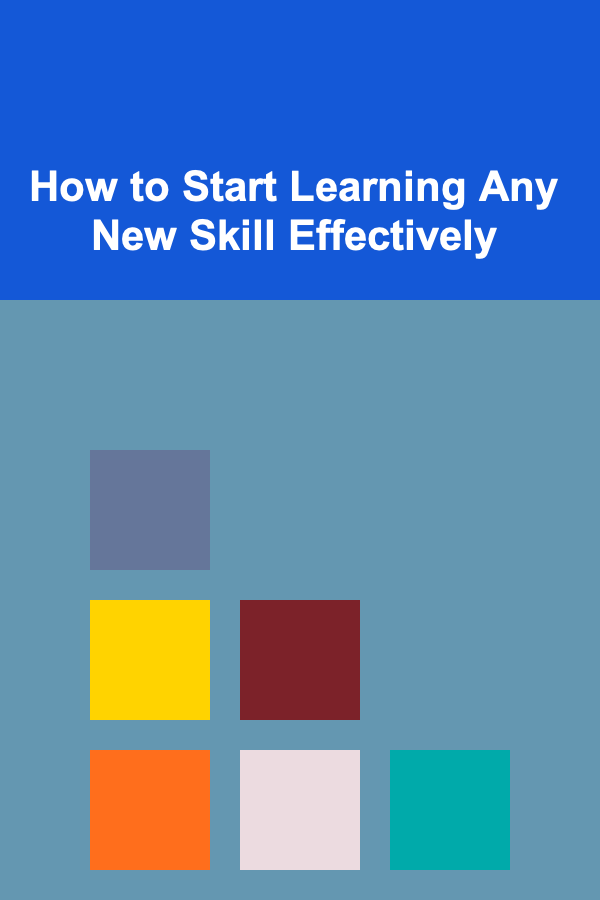
How To Develop a Personal Brand Through Content
ebook include PDF & Audio bundle (Micro Guide)
$12.99$9.99
Limited Time Offer! Order within the next:

In today's digital age, developing a personal brand has become one of the most essential strategies for standing out in a crowded market, whether you're a business professional, creative artist, or entrepreneur. A personal brand is more than just a logo or a catchy slogan; it is the embodiment of your identity, values, and expertise. One of the most effective ways to build and enhance your personal brand is through content creation. Content serves as the bridge between your audience and the message you wish to convey. It allows you to showcase your skills, establish trust, and communicate with your audience in a meaningful way.
This article will explore the various strategies and tactics for developing a personal brand through content. From identifying your niche to understanding your audience, crafting your message, and distributing it effectively, we'll walk through the steps you need to take to ensure your personal brand thrives through content.
Understanding Personal Branding
Before diving into the strategies for creating content that supports your personal brand, it's crucial to understand what personal branding really means.
What is Personal Branding?
Personal branding is the practice of marketing yourself and your career as a brand. It's about making a name for yourself in your field, building credibility, and positioning yourself as an expert. A personal brand allows you to stand out from the competition, attract opportunities, and build a loyal following. Your personal brand encompasses your values, skills, experiences, and personality, which are communicated through various channels, including social media, blogs, podcasts, and more.
The Role of Content in Personal Branding
Content is one of the most powerful tools in building a personal brand. It allows you to communicate who you are, what you stand for, and what value you can offer to your audience. By consistently producing content that aligns with your personal brand, you establish yourself as a thought leader, gain visibility, and connect with people who share your values and interests.
Content is not just about promoting your expertise or selling a product; it's about creating a narrative that resonates with your audience. It helps to demonstrate your credibility, build emotional connections, and provide value that keeps people coming back.
Identifying Your Niche
The first step in creating content that supports your personal brand is identifying your niche. A niche is a specific area of expertise or interest that sets you apart from others. It allows you to focus your efforts and target a more specific audience, making your content more relevant and valuable.
Why a Niche Matters
A niche is essential for standing out in a competitive digital landscape. Rather than trying to appeal to everyone, narrowing your focus enables you to craft messages that resonate more deeply with your target audience. A defined niche also helps to position you as an expert in a particular area, allowing you to differentiate yourself from others in your field.
How to Identify Your Niche
- Assess Your Skills and Passion: What are you truly passionate about? What skills do you excel at? Your personal brand should be aligned with your strengths and interests, as this authenticity will resonate with your audience.
- Evaluate Market Demand: Research what people are interested in within your area of expertise. What are they searching for? What problems do they need solving?
- Look for Gaps: Identify areas in your field where there are gaps in content or expertise. These gaps can provide an opportunity for you to fill a need and position yourself as the go-to expert.
- Define Your Audience: Who are you creating content for? Understand their demographics, interests, and pain points. This understanding will help guide the content you create.
Once you've identified your niche, you can begin to craft content that speaks directly to your target audience's needs and interests.
Crafting Your Message
Your message is the core of your personal brand. It's what you want to communicate to your audience, and it should reflect your values, expertise, and unique perspective. Crafting a compelling message requires you to understand who you are, what you offer, and why people should listen to you.
Key Elements of Your Message
- Authenticity: Your message should reflect who you truly are. Authenticity builds trust and allows you to connect with your audience on a deeper level. People are drawn to individuals who are genuine and transparent.
- Value: What value can you provide to your audience? Whether it's offering advice, solving problems, or entertaining, your content should offer something useful that your audience can benefit from.
- Differentiation: What makes you different from others in your field? Highlight what sets you apart, whether it's your unique approach, experience, or perspective.
How to Craft Your Message
- Know Your "Why": Why are you creating content? What is your purpose? Your message should be rooted in a sense of purpose and aligned with your goals.
- Create a Value Proposition: Define clearly what value you offer to your audience. Whether it's expertise, entertainment, or inspiration, your value proposition will help you focus your content efforts.
- Tell Your Story: Storytelling is one of the most powerful ways to convey your message. Share your journey, struggles, and successes to connect with your audience emotionally.
Content Creation Strategy
Once you have a clear understanding of your niche and message, it's time to develop a content creation strategy. Your strategy will outline the types of content you'll create, how often you'll post, and where you'll distribute your content.
Types of Content
- Blog Posts: Writing blog posts allows you to dive deep into topics related to your niche. Blog posts are great for sharing your expertise and driving traffic to your website.
- Social Media Posts: Social media platforms like Instagram, Twitter, LinkedIn, and Facebook are great for short-form content. Use these platforms to engage with your audience in real-time, share updates, and build a community.
- Videos: Video content is highly engaging and can be a great way to showcase your personality. Platforms like YouTube, TikTok, and Instagram Reels are popular for video content.
- Podcasts: Podcasts allow you to have in-depth conversations with guests or share your insights. They are perfect for individuals who want to build an audience through audio content.
- Newsletters: An email newsletter is a great way to stay connected with your audience and share valuable content directly with them.
Content Planning
To build a personal brand, consistency is key. A content calendar can help you plan and organize your content. Here are some steps to create an effective content plan:
- Set Goals: Define your goals for content creation. Are you aiming to increase your followers, drive traffic to your website, or establish yourself as an expert in your niche?
- Content Calendar: Create a schedule for when you'll publish content. A content calendar ensures that you're consistently creating and posting content, which is essential for growing your personal brand.
- Repurpose Content: Repurposing content allows you to get more value out of what you've created. For example, you can turn a blog post into a video, or an Instagram post into a podcast episode.
Creating Engaging Content
To capture the attention of your audience, your content must be engaging. Here are some tips for creating content that resonates with people:
- Be Informative: Your content should offer value to your audience, whether it's teaching them something new, solving a problem, or providing insight.
- Use Visuals: People are more likely to engage with content that includes visuals, such as images, infographics, or videos. Visual content makes your message more memorable and appealing.
- Be Authentic: As mentioned earlier, authenticity is key to building a strong personal brand. Don't try to be someone you're not---let your true personality shine through in your content.
- Encourage Engagement: Ask questions, encourage comments, and create content that invites your audience to participate. Engagement helps build a community around your personal brand.
Distributing Your Content
Creating great content is only half the battle. To build your personal brand, you need to get your content in front of the right people. Distribution is crucial for reaching your target audience and gaining visibility.
Social Media
Social media is one of the most powerful platforms for distributing content. Each platform has its own unique audience, so tailor your content accordingly:
- Instagram: Perfect for visual content, including images, videos, and stories. It's ideal for building a personal brand based on aesthetics and lifestyle.
- Twitter: Great for sharing quick thoughts, links, and engaging with your audience through short posts.
- LinkedIn: Ideal for professionals looking to build their personal brand in a business context. Share thought leadership articles, case studies, and industry insights.
- Facebook: Perfect for building a community through groups and sharing longer posts and updates.
- TikTok: A platform for creating short, engaging videos that capture attention quickly. Ideal for building a personal brand with a fun and creative edge.
Guest Blogging and Podcasts
Guest blogging and podcasts can also be effective ways to reach new audiences. By contributing to well-known blogs or being a guest on a podcast, you can leverage existing platforms to promote your personal brand and expand your reach.
Search Engine Optimization (SEO)
Search Engine Optimization (SEO) is the practice of optimizing your content to rank higher in search engine results. By optimizing your content with the right keywords, you can increase its visibility and attract more traffic to your website or blog. This is particularly important for long-form content like blog posts and articles.
Measuring Success
Once you've developed your content and distribution strategy, it's important to track your progress. Use analytics tools to measure how well your content is performing. Some key metrics to track include:
- Website Traffic: How many people are visiting your site as a result of your content?
- Engagement: Are people liking, commenting, and sharing your content?
- Followers and Subscribers: Are you growing your audience on social media or through your newsletter?
- Leads and Conversions: If you're using content to promote a product or service, track how many leads or conversions you're generating.
Tracking these metrics will help you fine-tune your strategy and ensure that you're effectively building your personal brand.
Conclusion
Developing a personal brand through content is a powerful way to establish yourself as an expert, build trust with your audience, and create long-lasting relationships. By focusing on a niche, crafting a clear message, creating valuable content, and distributing it effectively, you can set yourself apart from the competition and build a strong personal brand that resonates with your target audience.
Remember that consistency, authenticity, and engagement are key to a successful personal brand. As you continue to create and share content, your personal brand will evolve, allowing you to grow your influence and reach new heights in your career or business.

10 Thrifty Gardening Tips for a Beautiful Garden on a Budget
Read More
How to Motivate Yourself to Stick to a Home Cleaning Checklist
Read More
How to Offer Bookkeeping Services to Small Business Owners: A Comprehensive Guide
Read More
How to Start Learning Any New Skill Effectively
Read More
How To Practice Yoga for Flexibility in Legs
Read More
10 Tips for Coaching Youth Soccer Players
Read MoreOther Products

10 Thrifty Gardening Tips for a Beautiful Garden on a Budget
Read More
How to Motivate Yourself to Stick to a Home Cleaning Checklist
Read More
How to Offer Bookkeeping Services to Small Business Owners: A Comprehensive Guide
Read More
How to Start Learning Any New Skill Effectively
Read More
How To Practice Yoga for Flexibility in Legs
Read More